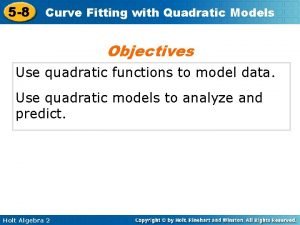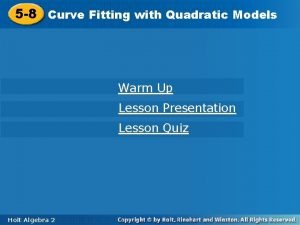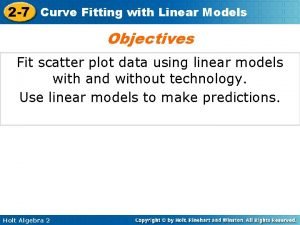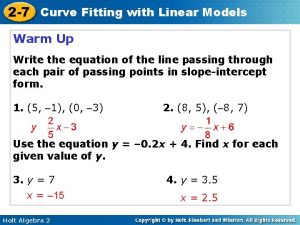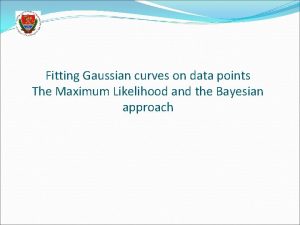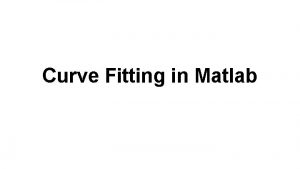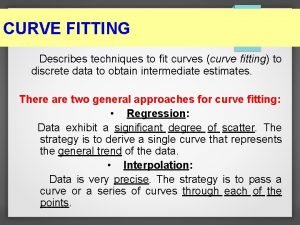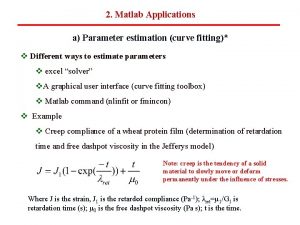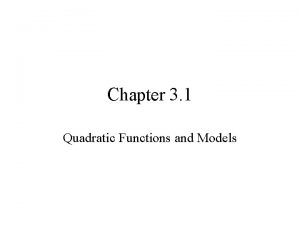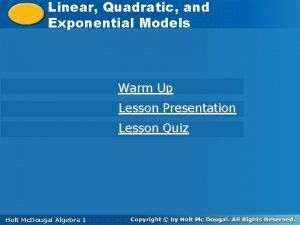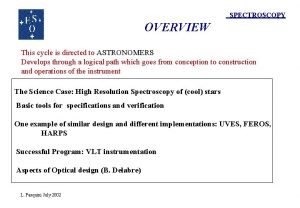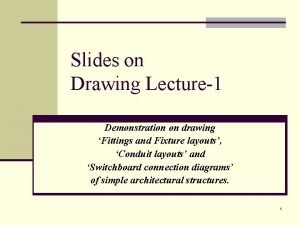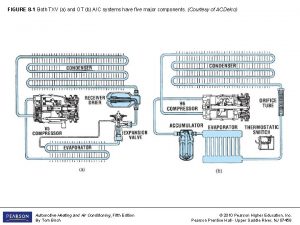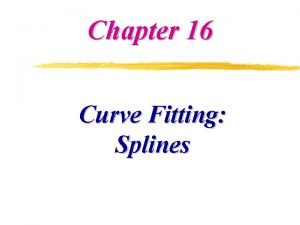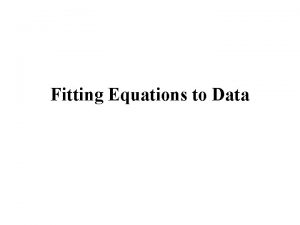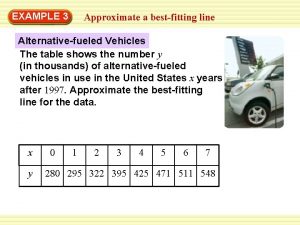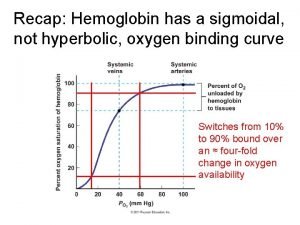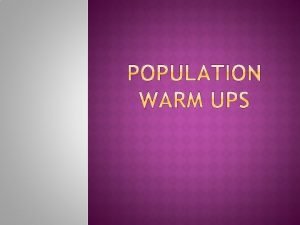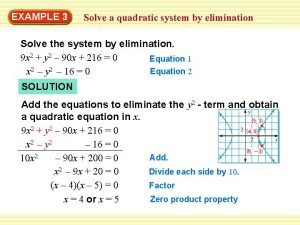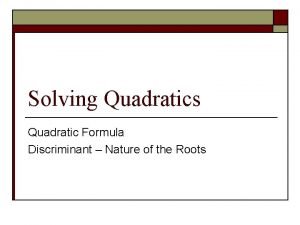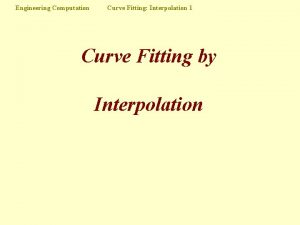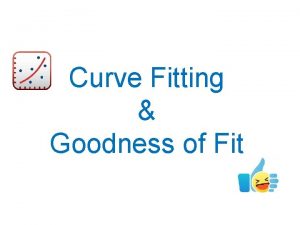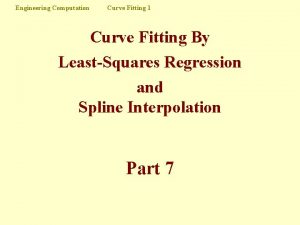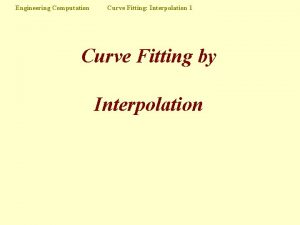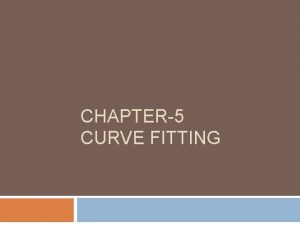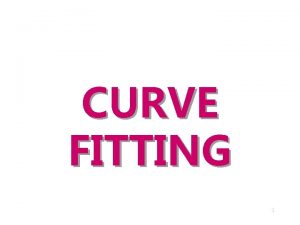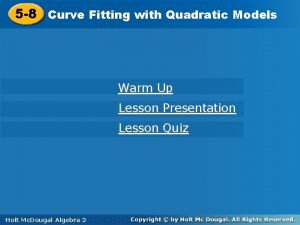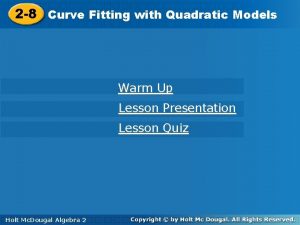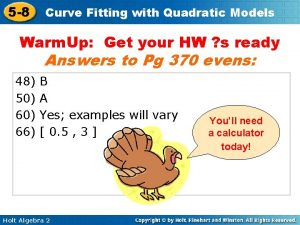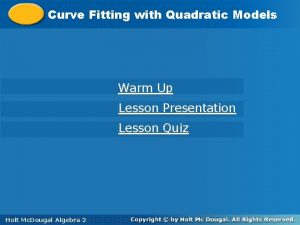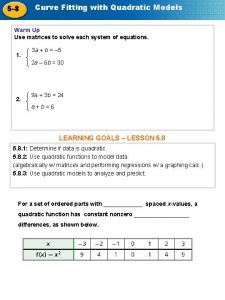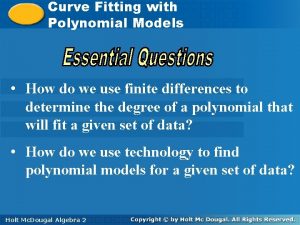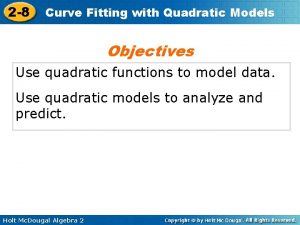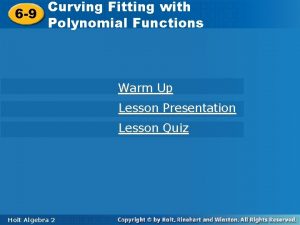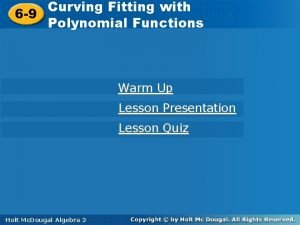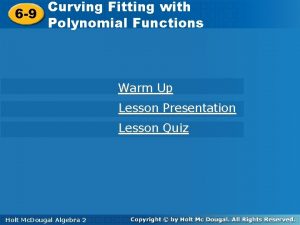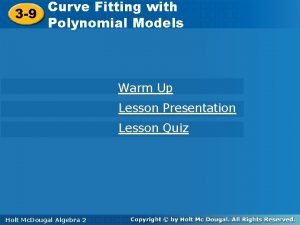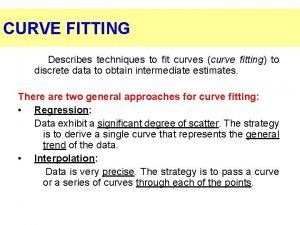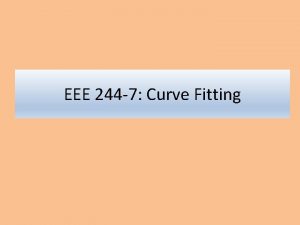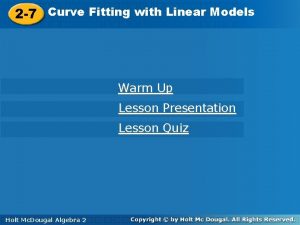5 8 Curve Fitting with Quadratic Models Warm


































- Slides: 34

5 -8 Curve Fitting with Quadratic Models Warm Up Lesson Presentation Lesson Quiz Holt Algebra 22

5 -8 Curve Fitting with Quadratic Models Warm Up Solve each system of equations. 1. 3 a + b = – 5 2 a – 6 b = 30 2. 9 a + 3 b = 24 a+b=6 3. 4 a – 2 b = 8 2 a – 5 b = 16 Holt Algebra 2 a = 0, b = – 5 a = 1, b = 5 a= , b = – 3

5 -8 Curve Fitting with Quadratic Models Objectives Use quadratic functions to model data. Use quadratic models to analyze and predict. Holt Algebra 2

5 -8 Curve Fitting with Quadratic Models Vocabulary quadratic model quadratic regression Holt Algebra 2

5 -8 Curve Fitting with Quadratic Models Recall that you can use differences to analyze patterns in data. For a set of ordered parts with equally spaced x-values, a quadratic function has constant nonzero second differences, as shown below. Holt Algebra 2

5 -8 Curve Fitting with Quadratic Models Example 1 A: Identifying Quadratic Data Determine whether the data set could represent a quadratic function. Explain. x y 1 3 5 7 9 – 1 1 7 17 31 Find the first and second differences. Equally spaced x-values x y 1 st 2 nd Holt Algebra 2 1 3 5 7 9 – 1 1 7 17 31 2 6 4 10 4 14 4 Quadratic function: second differences are constant for equally spaced xvalues

5 -8 Curve Fitting with Quadratic Models Example 1 B: Identifying Quadratic Data Determine whether the data set could represent a quadratic function. Explain. x y 3 4 5 6 7 1 3 9 27 81 Equally spaced x-values x y 1 st 2 nd Holt Algebra 2 3 4 5 6 7 1 3 9 27 81 2 6 4 18 12 54 36 Find the first and second differences. Not a Quadratic function: second differences are not constant for equally spaced x-values

5 -8 Curve Fitting with Quadratic Models Check It Out! Example 1 a Determine whether the data set could represent a quadratic function. Explain. x y 3 4 5 6 7 11 21 35 53 75 Find the first and second differences. Equally spaced x-values x y 1 st 2 nd Holt Algebra 2 3 4 5 6 7 11 21 35 53 75 10 14 4 18 4 22 4 Quadratic function: second differences are constant for equally spaced xvalues

5 -8 Curve Fitting with Quadratic Models Check It Out! Example 1 b Determine whether the data set could represent a quadratic function. Explain. x y 10 9 8 7 6 6 8 10 12 14 Find the first and second differences. Equally spaced x-values x y 1 st 2 nd Holt Algebra 2 10 9 8 7 6 6 8 10 12 14 2 2 0 2 0 Not a quadratic function: first differences are constant so the function is linear.

5 -8 Curve Fitting with Quadratic Models Just as two points define a linear function, three noncollinear points define a quadratic function. You can find three coefficients a, b, and c, of f(x) = ax 2 + bx + c by using a system of three equations, one for each point. The points do not need to have equally spaced x-values. Reading Math Collinear points lie on the same line. Noncollinear points do not all lie on the same line. Holt Algebra 2

5 -8 Curve Fitting with Quadratic Models Example 2: Writing a Quadratic Function from Data Write a quadratic function that fits the points (1, – 5), (3, 5) and (4, 16). Use each point to write a system of equations to find a, b, and c in f(x) = ax 2 + bx + c. (x, y) (1, – 5) f(x) = ax 2 + bx + c – 5 = a(1)2 + b(1) + c System in a, b, c 1 a + b + c = – 5 (3, 5) 5 = a(3)2 + b(3) + c 9 a + 3 b + c = 5 2 (4, 16) 16 = a(4)2 + b(4) + c 16 a + 4 b + c = 16 3 Holt Algebra 2 1

5 -8 Curve Fitting with Quadratic Models Example 2 Continued Subtract equation 1 to get 2 1 4 2 4 by. 9 a + 3 b + c = 5 a + b + c = – 5 8 a + 2 b + 0 c = 10 Holt Algebra 2 Subtract equation 3 by equation 1 to get 5. 16 a + 4 b + c = 16 a + b + c = – 5 3 1 5 15 a + 3 b + 0 c = 21

5 -8 Curve Fitting with Quadratic Models Example 2 Continued Solve equation elimination. 5 4 4 and equation 2(15 a + 3 b = 21) – 3(8 a + 2 b = 10) 5 for a and b using 30 a + 6 b = 42 – 24 a – 6 b = – 30 6 a + 0 b = 12 a =2 Holt Algebra 2 Multiply by 2. Multiply by – 3. Subtract. Solve for a.

5 -8 Curve Fitting with Quadratic Models Example 2 Continued Substitute 2 for a into equation get b. 4 or equation 5 to 8(2) +2 b = 10 15(2) +3 b = 21 2 b = – 6 b = – 3 3 b = – 9 Holt Algebra 2 b = – 3

5 -8 Curve Fitting with Quadratic Models Example 2 Continued Substitute a = 2 and b = – 3 into equation solve for c. 1 to (2) +(– 3) + c = – 5 – 1 + c = – 5 c = – 4 Write the function using a = 2, b = – 3 and c = – 4. f(x) = ax 2 + bx + c Holt Algebra 2 f(x)= 2 x 2 – 3 x – 4

5 -8 Curve Fitting with Quadratic Models Example 2 Continued Check Substitute or create a table to verify that (1, – 5), (3, 5), and (4, 16) satisfy the function rule. Holt Algebra 2

5 -8 Curve Fitting with Quadratic Models Check It Out! Example 2 Write a quadratic function that fits the points (0, – 3), (1, 0) and (2, 1). Use each point to write a system of equations to find a, b, and c in f(x) = ax 2 + bx + c. (x, y) (0, – 3) f(x) = ax 2 + bx + c – 3 = a(0)2 + b(0) + c System in a, b, c 1 c = – 3 (1, 0) 0 = a(1)2 + b(1) + c a+b+c=0 2 (2, 1) 1 = a(2)2 + b(2) + c 4 a + 2 b + c = 1 3 Holt Algebra 2 1

5 -8 Curve Fitting with Quadratic Models Check It Out! Example 2 Continued Substitute c = – 3 from equation 2 and equation 3. 2 a+b+c=0 a+b– 3=0 a+b=3 Holt Algebra 2 3 4 1 into both 4 a + 2 b + c = 1 4 a + 2 b – 3 = 1 4 a + 2 b = 4 5

5 -8 Curve Fitting with Quadratic Models Check It Out! Example 2 Continued Solve equation elimination. 4 5 4 and equation 4(a + b) = 4(3) 4 a + 2 b = 4 5 for b using 4 a + 4 b = 12 – (4 a + 2 b = 4) 0 a + 2 b = 8 b=4 Holt Algebra 2 Multiply by 4. Subtract. Solve for b.

5 -8 Curve Fitting with Quadratic Models Check It Out! Example 2 Continued Substitute 4 for b into equation to find a. 4 a+b=3 a+4=3 a = – 1 or equation 4 5 5 4 a + 2 b = 4 4 a + 2(4) = 4 4 a = – 4 a = – 1 Write the function using a = – 1, b = 4, and c = – 3. f(x) = ax 2 + bx + c Holt Algebra 2 f(x)= –x 2 + 4 x – 3

5 -8 Curve Fitting with Quadratic Models Check It Out! Example 2 Continued Check Substitute or create a table to verify that (0, – 3), (1, 0), and (2, 1) satisfy the function rule. Holt Algebra 2

5 -8 Curve Fitting with Quadratic Models You may use any method that you studied in Chapters 3 or 4 to solve the system of three equations in three variables. For example, you can use a matrix equation as shown. Holt Algebra 2

5 -8 Curve Fitting with Quadratic Models A quadratic model is a quadratic function that represents a real data set. Models are useful for making estimates. In Chapter 2, you used a graphing calculator to perform a linear regression and make predictions. You can apply a similar statistical method to make a quadratic model for a given data set using quadratic regression. Holt Algebra 2

5 -8 Curve Fitting with Quadratic Models Helpful Hint The coefficient of determination R 2 shows how well a quadratic function model fits the data. The closer R 2 is to 1, the better the fit. In a model with R 2 0. 996, which is very close to 1, the quadratic model is a good fit. Holt Algebra 2

5 -8 Curve Fitting with Quadratic Models Example 3: Consumer Application The table shows the cost of circular plastic wading pools based on the pool’s diameter. Find a quadratic model for the cost of the pool, given its diameter. Use the model to estimate the cost of the pool with a diameter of 8 ft. Diameter (ft) Cost Holt Algebra 2 4 $19. 95 5 6 7 $20. 25 $25. 00 $34. 95

5 -8 Curve Fitting with Quadratic Models Example 3 Continued Step 1 Enter the data into two lists in a graphing calculator. Holt Algebra 2 Step 2 Use the quadratic regression feature.

5 -8 Curve Fitting with Quadratic Models Example 3 Continued Step 3 Graph the data and function model to verify that the model fits the data. Holt Algebra 2 Step 4 Use the table feature to find the function value x = 8.

5 -8 Curve Fitting with Quadratic Models Example 3 Continued A quadratic model is f(x) ≈ 2. 4 x 2 – 21. 6 x + 67. 6, where x is the diameter in feet and f(x) is the cost in dollars. For a diameter of 8 ft, the model estimates a cost of about $49. 54. Holt Algebra 2

5 -8 Curve Fitting with Quadratic Models Check It Out! Example 3 The tables shows approximate run times for 16 mm films, given the diameter of the film on the reel. Find a quadratic model for the reel length given the diameter of the film. Use the model to estimate the reel length for an 8 -inchdiameter film. Holt Algebra 2 Film Run Times (16 mm) Diameter (in) 5 Reel Length Run Time (ft) (min) 200 5. 55 7 400 11. 12 9. 25 600 16. 67 10. 5 800 22. 22 12. 25 1200 33. 33 13. 75 1600 44. 25

5 -8 Curve Fitting with Quadratic Models Check It Out! Example 4 Continued Step 1 Enter the data into two lists in a graphing calculator. Holt Algebra 2 Step 2 Use the quadratic regression feature.

5 -8 Curve Fitting with Quadratic Models Check It Out! Example 4 Continued Step 3 Graph the data and function model to verify that the model fits the data. Holt Algebra 2 Step 4 Use the table feature to find the function value x = 8.

5 -8 Curve Fitting with Quadratic Models Check It Out! Example 4 Continued A quadratic model is L(d) 14. 3 d 2 – 112. 4 d + 430. 1, where d is the diameter in inches and L(d) is the reel length. For a diameter of 8 in. , the model estimates the reel length to be about 446 ft. Holt Algebra 2

5 -8 Curve Fitting with Quadratic Models Lesson Quiz: Part I Determine whether each data set could represent a quadratic function. 1. x y 5 6 7 8 9 5 8 13 21 34 2. x y 2 3 4 5 6 1 11 25 43 65 not quadratic 3. Write a quadratic function that fits the points (2, 0), (3, – 2), and (5, – 12). f(x) = –x 2 + 3 x – 2 Holt Algebra 2

5 -8 Curve Fitting with Quadratic Models Lesson Quiz: Part II 4. The table shows the prices of an ice cream cake, depending on its side. Find a quadratic model for the cost of an ice cream cake, given the diameter. Then use the model to predict the cost of an ice cream cake with a diameter of 18 in. Diameter (in. ) Cost 6 $7. 50 10 $12. 50 15 $18. 50 Holt Algebra 2 f(x) – 0. 011 x 2 + 1. 43 x – 0. 67; $21. 51
 Quadratic curve fitting
Quadratic curve fitting Curve fitting with quadratic models
Curve fitting with quadratic models Curve fitting with polynomial models
Curve fitting with polynomial models Curve fitting with linear models
Curve fitting with linear models Curve fitting with linear models
Curve fitting with linear models Exponential and logarithmic models
Exponential and logarithmic models Gaussian curve fitting
Gaussian curve fitting Labview curve fitting
Labview curve fitting Curve fitting matlab
Curve fitting matlab Curve fitting techniques
Curve fitting techniques Matlab parameter estimation
Matlab parameter estimation Modal and semi modal verbs
Modal and semi modal verbs Quadratic functions and models
Quadratic functions and models Linear quadratic and exponential models
Linear quadratic and exponential models Hyades
Hyades Matlab
Matlab Loose-fitting clothing
Loose-fitting clothing W&w glass systems
W&w glass systems Conduit layout drawing
Conduit layout drawing A/c fitting size chart
A/c fitting size chart Castan golf fitting
Castan golf fitting Spline fit matlab
Spline fit matlab Fitting equations to data
Fitting equations to data Steer clipping and fitting techniques
Steer clipping and fitting techniques Approximate the best fitting line for the data
Approximate the best fitting line for the data Transformer fitting
Transformer fitting Fitting into society
Fitting into society Taper key design
Taper key design Dr comfort return form
Dr comfort return form S curve and j curve
S curve and j curve Hill coefficient less than 1
Hill coefficient less than 1 S curve and j curve
S curve and j curve Significance of balanced occlusion
Significance of balanced occlusion How to solve quadratic equations by elimination
How to solve quadratic equations by elimination Quadratic formula examples
Quadratic formula examples
